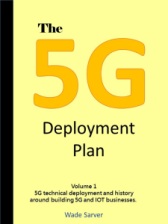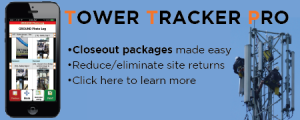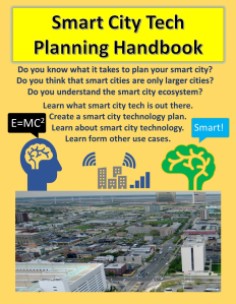Podcast: Play in new window | Download | Embed
Subscribe: Apple Podcasts | RSS
This is part three of a three-part series. This has been taken from my upcoming book, Smart City Use Cases, with Smart City Development Notes.
City Strategies for a Broadband Initiative
There are several strategies for any city to start the initiative.
- Do you want to undertake this effort? Is this something that you need for the city? Can you build a story around it?
- Weigh out your options to get started? This is the first step.
- Will you do it yourself or gather partners?
- If you partner, which you probably will, who do you reach out to? Think about whom it will benefit. It could help the universities and the local businesses. Start with them first because they have the most to gain. Broadband attracts business and talent, both of which help the local universities and cities.
- Look at what’s been done. Are there groups, like Next Century Cities and Smart Cities Council, that you can reach out to for help? Are there other cities that would offer advice? Of course! Do some research and look them up.
- Once you have a partner and maybe a high-level plan, then what?
- Will you own the network?
- Will you want local businesses to build out the network?
- Will you offer incentives, like easing the permitting process, offering city assets, or other things to promote local business to deploy?
Let’s Review
Let’s review some lessons that Gig.U taught us. I am summarizing from their Next Gen Handbook found at http://www.gig-u.org/cms/assets/uploads/2016/12/next-gen-handbook-v2.pdf to  help make this easier. (In my words.) I changed the order by what I thought would be more important. I explain what I think is important that somewhat aligns with Gig.U. I speak from case studies and my personal experience.
help make this easier. (In my words.) I changed the order by what I thought would be more important. I explain what I think is important that somewhat aligns with Gig.U. I speak from case studies and my personal experience.
- Community buy-in! This is essential to have the community buy-in and have stakeholders in the community that want this to happen. Local resources help things move and continue moving. The problem with partners and consultants is that if they don’t have the support of the community, the project will die a slow miserable and painful death. Don’t let this happen to your project! Find people and groups in the community that want this to happen as much as you do! Residents and especially local activist groups will make or break you. Get their buy-in and have them be supportive from day 1 to day 400. (Builds take a long time, well more than a few years, you will need all the help you can get to stay motivated.)
- Local Leadership is critical! If you don’t have the local politicians on board, then it is an uphill battle. Even if you do have the local political leaders, who’s to say they will continue to support you without the local community and activist groups. Politicians are
 fickle. They will support you for 2 reasons. One – because they truly believe in the cause that high broadband will make residents and business happy and build a new business in their community. While this is great, very few have the vision to see it through, Philadelphia is a great example. When Earthlink was building out Philadelphia, the local politicians were as fickle as the win, and they certainly didn’t commit any money to the project. When the local unions complained, the politicians turned on Earthlink as quickly as the Philadelphia wind changed. (About 10 minutes for those of you wondering.) It takes great leadership to make this go through, like Mayor Bloomberg in NYC, he has the grit to see the greater good, unlike the group of politicians in Philadelphia who chose to shut the system down after it was built and operation due to lack of interest and money. In my opinion, they had no grit and preferred to be remembered as a failed system, which they blamed Earthlink, that innovators. They are leaving the innovation up to the residents, who innovate despite the local government.
fickle. They will support you for 2 reasons. One – because they truly believe in the cause that high broadband will make residents and business happy and build a new business in their community. While this is great, very few have the vision to see it through, Philadelphia is a great example. When Earthlink was building out Philadelphia, the local politicians were as fickle as the win, and they certainly didn’t commit any money to the project. When the local unions complained, the politicians turned on Earthlink as quickly as the Philadelphia wind changed. (About 10 minutes for those of you wondering.) It takes great leadership to make this go through, like Mayor Bloomberg in NYC, he has the grit to see the greater good, unlike the group of politicians in Philadelphia who chose to shut the system down after it was built and operation due to lack of interest and money. In my opinion, they had no grit and preferred to be remembered as a failed system, which they blamed Earthlink, that innovators. They are leaving the innovation up to the residents, who innovate despite the local government. - It’s not enough to build a plan, but you need the story, budget and goals to be laid out clearly. The truth is the budget is a guess, an educated guess, but these things always take longer and seem to cost more than originally anticipated. BUT, you need to start somewhere. Build a vision of what you and your partners expect to happen. Be honest and show people what it takes. See if they have the stomach to work through it or if they will cower away and home the local cable company gets off its ass and build something without screwing the residents. It’s your call, but it takes grit, something that most city leadership does not have. They blame everything. They say we don’t have the money or what if it fails or what if the residents don’t want high-speed internet access. Listen, get partners to pay, it won’t fail, and who doesn’t want high-speed internet access? The government doesn’t pay for their access because the local taxes cover it, so they don’t care, do they? When they get home, they probably use a smartphone they got from work, again, paid for the local taxpayer. Most school kids don’t have that luxury, yet they don’t’ care, they have what they need, screw the other residents in that city. (My opinion here)
- It’s hard to plan and execute! Yes, it is, again, grit and a get’re done attitude is needed.
- In most cases, incumbents will react, not initiate! That is The local cable companies normally won’t do jack until they see a clear and present competitor. Examples are Nashville, TN, where AT&T and Comcast fought to keep Google Fiber off the poles. Then in College Station, TX, where Suddenlink put $250 Million aside to upgrade the network only after they saw a clear competitor in the local government who issued an RFP to build the local network. To be clear, Suddenlink didn’t announce anything until after the RFP hit the streets. The community wanted broadband in the worst way, Suddenlink didn’t do jack until the RFP was real, then it looks like they panicked and moved ahead. Sometimes a kick in the ass is needed to get these guys to listen to the community. Competition is just the kick in the ass
 they needed.
they needed. - Did you do an audit? Most cities wait until after they initiate several consultants to do an audit. They should be proactive and see what they really have available ahead of time. Prior to the actual engagement of partners and consultants. However, they don’t. It adds time to the entire process. Just do it, audit what you have and align with the local utilities to see how they will cooperate with you on this venture. Let them be the heroes if that’s what it takes. Think of the residents, not yourself! What we need now is a team and to align with the local utilities is a great place to start and ask for buy-in. We need the residents, local businesses, and the local utilities to get this moving. Work to get their buy-in and resources to move ahead. If you need help, let me know. What you need to know is: 1) what assets do we have? 2) what assets do we have access to? 3) who can we partner with to make this happen? 4) what assets don’t we have, and can’t we touch? Don’t worry, the local ISPs and Cable Companies will clue you in, either in a good way or a horribly competitive way.
- There are multiple solutions, pick one! I think you see here each city, municipality, town, or community has its own specific solution. If you’re looking for a “One size fits all” solution, good luck. It’s OK to see what others have done and copied it, but you will soon see that they all did something a little bit Pick you best plan to move forward then execute.
- Be persistent and be nimble! It takes persistence to keep moving, but don’t be afraid to pivot and make changes. You will need to rely on the flexibility of your partners to keep things moving ahead. The only thing you should be rigid on is the result, not the way you deploy. You may need wireless to get some fiber blocks, so do it. You may need to gain access to some buildings to bypass some poles that the incumbents would not let you on, do it. Don’t hesitate to the point where it stops the project. Be nimble and open-minded. It takes some creativity to keep moving ahead. Be open in receiving suggestions.
- It needs to be scalable and sustainable! Don’t forget that you will want to expand, so keep the option open to grow. It needs to be sustainable, do keep an eye on the payback. You want your income to cover the costs. If they don’t then next group of politicians will shut it down or make the deployment harder for contractors even if the locals get pissed. They won’t care if the system is bleeding money.
- Don’t be afraid of failure. Sometimes you need to keep the dream

alive even if this didn’t work. Maybe a partner or local business could step in to make this dream a reality, maybe they know something you didn’t, so be open to accepting help.
Please! Follow me on WordPress, Amazon, Twitter, LinkedIn, or Facebook. Just click and follow! Thank you! Get all your updates via email!
Resources
- http://www.gig-u.org/
- http://www.gig-u.org/cms/assets/uploads/2016/12/next-gen-handbook-v2.pdf
- https://fiber.storage.googleapis.com/legal/googlefibercitychecklist2-24-14.pdf
- https://www.benton.org/sites/default/files/broadbandinclusion.pdf
- https://toolkit.fiberbroadband.org/p/cm/ld/fid=367
- https://www.fiberbroadband.org/p/cm/ld/fid=364
- https://www.fiberbroadband.org/p/bl/et/blogid=3&blogaid=305
- https://www.nten.org/NTEN_images/reports/2016.DIF_Toolkit.pdf
- https://muninetworks.org/
- https://www2.ntia.doc.gov/
- http://www.shlb.org/uploads/G2G/Broadband%20Action%20Plan_SHLB.pdf
- https://www2.ntia.doc.gov/SBDD
- https://phila.legistar.com/LegislationDetail.aspx?ID=2506517&GUID=4C211499-C74A-4BCC-8A4C-6ECC2B2BB39A&Options=ID|Text|&Search=comcast+franchise+agreement
- https://phila.legistar.com/View.ashx?M=F&ID=4183902&GUID=CE2DB8A7-1225-4435-ACC3-EE3F8071238B
- https://drive.google.com/file/d/0ByIH-ljsInFIbEVJMWozRFVvVlU/view
- https://drive.google.com/file/d/0B75hXlxAwjAZc3VFbDhWMDFpanM/view
- https://drive.google.com/file/d/0B75hXlxAwjAZXzBPSGhoRnZseTg/view
- https://drive.google.com/file/d/0B75hXlxAwjAZS1U1MmRPQnJER0E/view
- https://drive.google.com/file/d/0B75hXlxAwjAZNzY2ZTNOSVFobUE/view
- https://us-ignite.org/
- https://www.eda.gov/grants/
- http://www.shlb.org/
- http://nextcenturycities.org/
- https://www.newamerica.org/oti/wireless-future-project/
- https://www.livingcities.org/
Be smart, be safe, and pay attention!
See Ya!
Sign-up to get all your updates!
How do you plan goals? Now you can plan 5 Weeks at a time! The 5-week Planning Journal, (click here), available now in paperback from Amazon!
The foundations below do beautiful work, helping families in their time of need. Climbers often get seriously injured or die on the job. The foundations below support those families in their time of greatest need!






 Putting together your smart city tech solutions, planning, development, and more….TechFecta! Guiding you to a better plan through consulting!
Putting together your smart city tech solutions, planning, development, and more….TechFecta! Guiding you to a better plan through consulting!


















